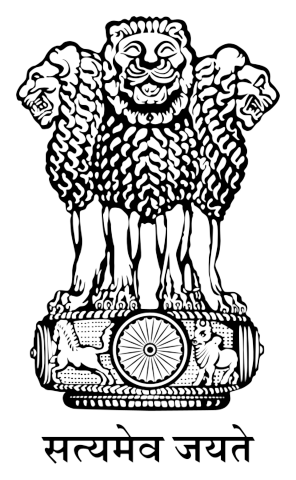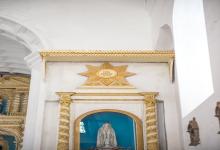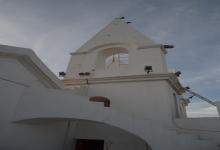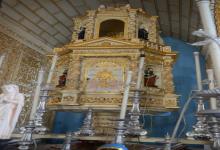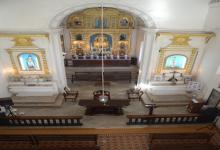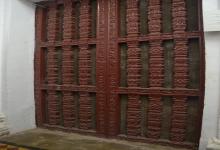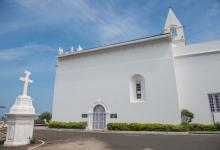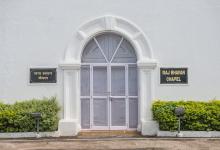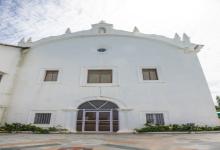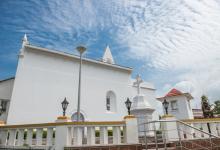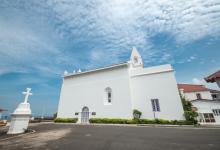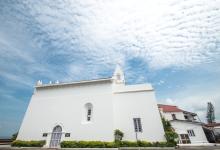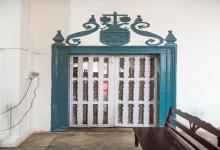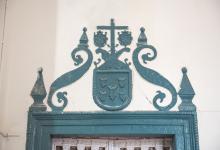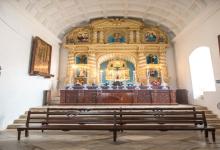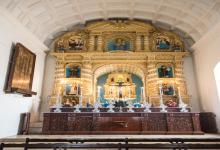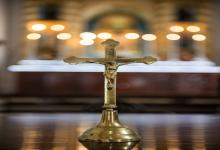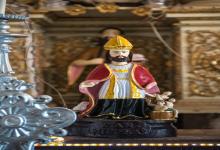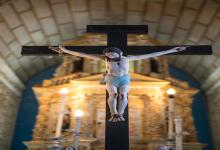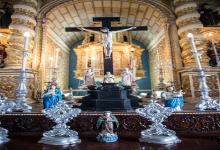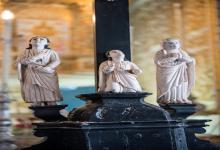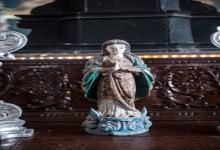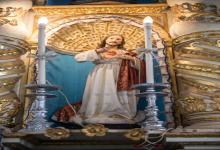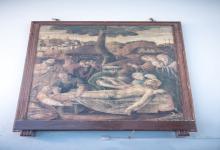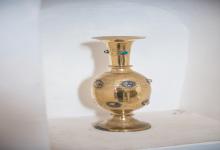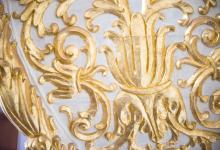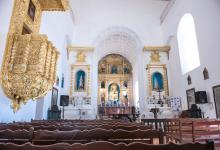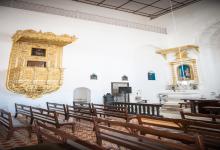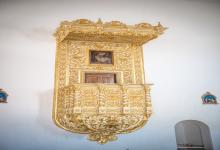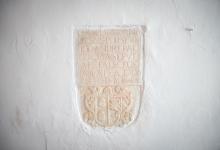It is small yet extremely elegant. The main altar is of wood with very rich carvings and painted in white and gold. It was probably erected in the early seventeenth century alongwith the renovations and additions which had been made by the Governor-General D. Matias de Albuquerque.
Main Altar : The image of the Virgin Mary of the Cape is displayed on the top ot the main altar. It is flanked to the right by the image of St. Francis de Assisi and to the left by that of St. Clara of Assisi. A very beautiful piece is that of Jesus Christ on the Cross. At his feet is Virgin Mary looking up towards her son in deep anguish and with folded hands. On the left is a standing figure of St. John in reverential thought and prayer. At the feet is a figure of Mary Magdalena. All the figures are beautifully carved form ivory. The heads of Mary and St. John are curving inwards showing that they were carved along the contours of the top portion of the ivory tusks.
Above the altar are eight pointed stars. The number eight is a symbol of regeneration. During the middle ages, because of its implication of regeneration, eight was considered as an emblem of baptismal waters. The star is the symbol of the spirit and stands for the forces of the spirit struggling against the forces of darkness. The presence of these eight stars is therefore fairly significant as it is a combination of a mission of evangelisation, associated with the Franciscans who had come to the east, and the Indian mystic cosmogony where eight stars imply that planetary influences had been warded off.
The Pulpit : In the main hall of the chapel, to the left, is an elaborately carved pulpit with twisted shafts which is no longer used. It is of the same period and style as the main altar. There are also two paintings adorning the walls to the right and left of the altar. One of the paintings shows Jesus being arrested and held tight by a man behind a pillar. The other painting depicts the body of Jesus after he had been taken off the cross being wrapped after the application of spices in accordance with the Jewish custom of preparing a body for burial. The mourning Virgin Mary is seen holding the head of Jesus Christ in great sorrow. Both these paintings appear to have been done by an Indian artist and probably belong to the seventeenth century.
Another remarkable piece in the chapel is a figure of the infant Jesus. This figure has a silver crown on its head and is made out of ivory imported from Moazambique. The infant Jesus is nude. In his left hand is a globe which had a cross on the top which is no longer there. This is a common depiction reflecting the rue of the cross over the entire globe. The figure is almost one foot in height and weighs two kilograms. The workmanship is of remarkable quality and is one of the finest figures in ivory of the infant Jesus to be found anywhere in Goa. It belongs to the early seventeenth century, by when there was a flourishing trade in ivory from Africa.
Tombstones in the Chapel : There are a number of tombstones along the walls of the chapel. The most interesting however is a black-granite tombstone with an inscription recording the death of D. Paula Menezes on 21st December 1682. The area where the Cabo is located goes by the name of Dona Paula. There are a number of popular stories relating to Dona Paula. She was the blonde wife of Antonio do Souto Maior and lived in a hamlet along the shores of the peninsula in the bay of the Zuari river. According to one legend, she had served as a lady-in-waiting to the then Viceroy. He had been enticed by her and became her ardent paramour. The Vicereine had her killed. According to another local legend, Dona Paula fell in love with a local fisherman. There were severe objections to her relationship. She was harassed and tormented and she eventually committed suicide.
Which of the two stories is correct or whether either is true, is a matter of conjecture. It is however puzzling that her body should have been interred in the chapel when such an honour is only reserved for the high and mighty. The suicide story would get ruled out as any one who committed suicide would never be buried in a chapel. If a Vicereine had Dona Paula killed, it is most unlikely that she would have tolerated her husband???s paramour being buried in the chapel. Nevertheless, the legends persist and her death will remains engraved permanently in a tombstone which continues to adorn the wall of the chapel at the Cabo.
There is a door which leads from the chapel to the sacristy and a courtyard of the cloisters which were built for the convent. The ancient door leading to the sacristy resembles the door of a Hindu temple. It could thus have been the work of local craftsmen. The doorway itself is made of granite and on its top is a coat of arms with a cross. It is probably the coat of arms of Bishop de Andrade de Santa Maria who had laid the foundation stone of the rebuilt chapel in 1594.
The cloisters have remained almost the same over the centuries. The rooms of the monks have been converted into guest rooms. In the centre is an open courtyard with a large fountain. At the other end of the cloisters is an antique two-panel door which was transferred to the Cabo Palace in the middle of the century from one of the decaying convents in Old Goa. It is one of the most beautiful doors in all of Goa. At the top corners of the door are two angels indicating divine protection. Below it is an arch with twelve quadrangular niches which bear ornate floral designs. There is a circular area which is designed to symbolise spiritual life. Underneath are two identical coats of arms with the Crown. These resemble the royal coat of arms of King D. Afonso III. The door was made during his reign as a tribute to the ruling sovereign in Portugal. Along with it in the centre is a trefoil cross which resembles the royal coat of arms of Aviz.
Below the coats of arms are eight-rayed suns symbolising glory, spirituality and illumination. This solar symbolism also indicates the divine eye. Underneath the sun is the symbol in duplicate of the crown with a five-pointed star. This could be taken to signify the patronage of the crown. At the bottom, duplicate images of a dog, with a stick-like object in its mouth, have been carved. The dog is considered as a symbol of faithfulness. The door is therefore remarkable not only for its carvings, but for the spectrum of figures conveying divine patronage, the protection of the crown and the church, and the symbols of eternal energy, light and abiding faithfulness.
The chapel continues to be open for worship. Mass is held on Sundays and special feast days. The feast of Our Lady of the Cape is celebrated on the 15 August every year by the staff of the Cabo and the public. It just so happens that 15 august is also India???s Independence Day.
August is also the month of harvesting and there is a long-standing tradition that the villagers of Taleigao come to call on the Governor on the first day of harvesting. They bring their first produce all dressed up in their Sunday best. This tradition owes its origin to the time of Albuquerque who was welcomed by the Hindu villagers of Taleigao so that they could be protected from Muslim rule. In lieu of protection, the villagers were converted to Christianity and have since then given the first produce of their harvest to the Governor and the Archbishop.



